Weakened Impacts of the East Asia-Pacific Teleconnection on the Interannual Variability of Summertime Precipitation over South China since the Mid-2000s
Abstract
1. Introduction
2. Materials and Methods
3. Results
3.1. Weakened Interannual Variability of Summer Precipitation over SC since the Mid-2000s
3.2. Atmospheric Circulation Anomalies Responsible for the Interdecadal Shift of Summertime Precipitation over SC
3.3. Weakened Impacts of the EAP Teleconnection on Summertime Precipitation over SC since the Mid-2000s
4. Conclusions
Author Contributions
Funding
Acknowledgments
Conflicts of Interest
References
- Chen, G. Comments on “Interdecadal Change of the South China Sea Summer Monsoon Onset”. J. Clim. 2022, 28, 9029–9035. [Google Scholar] [CrossRef]
- Huang, R.H.; Chen, J.; Wang, L.; Lin, Z.D. Characteristics, processes, and causes of the spatio-temporal variabilities of the East Asian monsoon system. Adv. Atmos. Sci. 2012, 29, 910–942. [Google Scholar] [CrossRef]
- Yao, R.; Ren, X. Decadal and Interannual Variability of Persistent Heavy Rainfall Events over the Middle and Lower Reaches of the Yangtze River Valley. J. Meteorol. Res. 2019, 33, 1031–1043. [Google Scholar] [CrossRef]
- Wang, H.J.; Fan, K. Recent changes in the East Asian monsoon. Chin. J. Atmos. Sci. 2013, 37, 313–318. (In Chinese) [Google Scholar]
- Ma, W.Q.; Huang, W.Y.; Yang, Z.F.; Wang, B.; Lin, D.Y.; He, X.S. Dynamic and Thermodynamic Factors Associated with Different Precipitation Regimes over South China during Pre-Monsoon Season. Atmosphere 2018, 9, 219. [Google Scholar] [CrossRef]
- Miao, R.; Wen, M.; Zhang, R.; Li, L. The influence of wave trains in mid-high latitudes on persistent heavy rain during the first rainy season over South China. Clim. Dyn. 2019, 53, 2949–2968. [Google Scholar] [CrossRef]
- Li, X.; Wang, C.; Lan, J. Role of the South China Sea in Southern China rainfall: Meridional moisture flux transport. Clim. Dyn. 2021, 56, 2551–2568. [Google Scholar] [CrossRef]
- Ji, Y.; Sun, X.; Xu, Y.; Yao, J.; Yang, X.Q. Summer Regional Pentad Extreme Precipitation in Eastern China and Their Possible Causes. Front. Earth Sci. 2021, 8, 598025. [Google Scholar] [CrossRef]
- Zhang, R.H. Natural and human-induced changes in summer climate over the East Asian monsoon region in the last half century: A review. Adv. Clim. Change Res. 2015, 6, 131–140. [Google Scholar] [CrossRef]
- Zhang, R.H. Changes in East Asian summer monsoon and summer rainfall over eastern China during recent decades. Sci. Bull. 2015, 60, 1222–1224. [Google Scholar] [CrossRef]
- Sun, S.; Ren, Y.; Li, Q.; Zhou, S.; Zhao, C.; Chai, R.; Wang, J. Intra-annual differences of 3-month Standardized Precipitation-Evapotranspiration Index dryness/wetness sensitivity over southwest China. Atmos. Sci. Lett. 2018, 19, e830. [Google Scholar] [CrossRef]
- Cao, X.; Liu, Y.; Wu, R.; Bi, M.; Dai, Y.; Cai, Z. Northwestwards shift of tropical cyclone genesis position during autumn over the western North Pacific after the late 1990s. Int. J. Climatol. 2019, 40, 1885–1899. [Google Scholar] [CrossRef]
- Yang, R.; Wang, J. Interannual variability of the seesaw mode of the interface between the Indian and East Asian summer monsoons. Clim. Dyn. 2019, 53, 2683–2695. [Google Scholar] [CrossRef]
- Zhao, H.; Zhao, K.; Klotzbach, P.J.; Wu, L.; Wang, C. Interannual and interdecadal drivers of meridional migration of Western North Pacific tropical cyclone lifetime maximum intensity location. J. Clim. 2022, 35, 2709–2722. [Google Scholar] [CrossRef]
- Liu, F.; Wang, B.; Ouyang, Y.; Wang, H.; Qiao, S.; Chen, G.; Dong, W. Intraseasonal variability of global land monsoon precipitation and its recent trend. Npj Clim. Atmos. Sci. 2022, 5, 30. [Google Scholar] [CrossRef]
- Zhu, Y.L.; Wang, H.J.; Zhou, W.; Ma, J. Recent changes in the summer precipitation pattern in East China and the background circulation. Clim. Dyn. 2011, 36, 1463–1473. [Google Scholar] [CrossRef]
- Xin, X.; Yu, R.; Zhou, T.; Wang, B. Drought in Late Spring of South China in Recent Decades. J. Clim. 2006, 19, 3197–3206. [Google Scholar] [CrossRef]
- Ye, H.; Lu, R.Y. Dominant patterns of summer rainfall anomalies in East China during 1951–2006. Adv. Atmos. Sci. 2012, 29, 695–704. [Google Scholar] [CrossRef]
- Wang, H.J. The weakening of the Asian monsoon circulation after the end of 1970’s. Adv. Atmos. Sci. 2001, 18, 376–386. [Google Scholar] [CrossRef]
- Li, H.; Dai, A.; Zhou, T.; Lu, J. Responses of East Asian summer monsoon to historical SST and atmospheric forcing during 1950–2000. Clim. Dyn. 2010, 34, 501–514. [Google Scholar] [CrossRef]
- Yu, L.; Furevik, T.; Otterå, O.H.; Gao, Y. Modulation of the Pacific Decadal Oscillation on the summer precipitation over East China: A comparison of observations to 600-years control run of Bergen Climate Model. Clim. Dyn. 2015, 44, 475–494. [Google Scholar] [CrossRef]
- Wang, B.; Huang, F.; Wu, Z.; Yang, J.; Fu, X.; Kikuchi, K. Multi-scale climate variability of the South China Sea monsoon: A review. Dyn. Atmos. Ocean. 2009, 47, 15–37. [Google Scholar] [CrossRef]
- Ha, Y.; Zhong, Z.; Chen, H.; Hu, Y. Out-of-phase decadal changes in boreal summer rainfall between Yellow-Huaihe River valley and southern China around 2002/2003. Clim. Dyn. 2016, 47, 137–158. [Google Scholar] [CrossRef]
- Ha, Y.; Zhong, Z.; Hu, Y.; Zhu, Y.; Zang, Z.; Zhang, Y.; Yao, Y.; Sun, Y. Differences between decadal decreases of boreal summer rainfall in southeastern and southwestern China in the early 2000s. Clim. Dyn. 2019, 52, 3533–3552. [Google Scholar] [CrossRef]
- Wu, B.; Li, T.; Zhou, T.J. Relative contributions of the Indian Ocean and local SST anomalies to the maintenance of the western North Pacific anomalous anticyclone during the El Niño decaying summer. J. Clim. 2010, 23, 2974–2986. [Google Scholar] [CrossRef]
- Zhu, Z.W.; Li, T.; He, J.H. Out-of-phase relationship between boreal spring and summer decadal rainfall changes in southern China. J. Clim. 2014, 27, 1083–1099. [Google Scholar] [CrossRef]
- Zhang, Y.S.; Li, T.; Wang, B. Decadal change of the spring snow depth over the Tibetan Plateau: The associated circulation and influence on the East Asian summer monsoon. J. Clim. 2004, 17, 2780–2793. [Google Scholar] [CrossRef]
- Ha, Y.; Zhong, Z.; Sun, Y.; Lu, W. Decadal change of South China Sea tropical cyclone activity in mid-1990s and its possible linkage with intraseasonal variability. J. Geophys. Res. Atmos. 2014, 119, 5331–5344. [Google Scholar] [CrossRef]
- Nitta, T. Convective activities in the tropical western Pacific and their impact on the Northern Hemisphere summer circulation. J. Meteorol. Soc. Jpn. 1987, 65, 373–390. [Google Scholar] [CrossRef]
- Wu, B.; Zhou, T.; Li, T. Impacts of the Pacific–Japan and Circumglobal Teleconnection Patterns on the Interdecadal Variability of the East Asian Summer Monsoon. J. Clim. 2016, 29, 3253–3271. [Google Scholar] [CrossRef]
- Huang, R.H.; Li, W.J. Influence of heat source anomaly over the western tropical Pacific on the subtropical high over East Asia and its physical mechanism. Chin. J. Atmos. Sci. 1988, 12 (Suppl. S1), 107–116. (In Chinese) [Google Scholar]
- Kurihara, K.; Tsuyuki, T. Development of the barotropic high around Japan and its association with Rossby wave-like propagations over the North Pacific: Analysis of August 1984. J. Meteorol. Soc. Jpn. 1987, 65, 237–246. [Google Scholar] [CrossRef][Green Version]
- Wakabayashi, S.; Kawamura, R. Extraction of major teleconnection patterns possibly associated with the anomalous summer climate in Japan. J. Meteorol. Soc. Jpn. 2004, 82, 1577–1588. [Google Scholar] [CrossRef]
- Sun, Y.; Xu, H.M.; Deng, J.C. Interdecadal variation in Pacific−Japan teleconnection patterns and possible causes. Chin. J. Atmos. Sci. 2014, 38, 1055–1065. (In Chinese) [Google Scholar]
- Yin, X.; Zhou, L.; Huangfu, J. Weakened Connection between East China Summer Rainfall and the East Asia-Pacific Teleconnection Pattern. Atmosphere 2021, 12, 704. [Google Scholar] [CrossRef]
- Xu, P.; Wang, L.; Chen, W.; Feng, J.; Liu, Y. Structural Changes in the Pacific–Japan Pattern in the Late 1990s. J. Clim. 2019, 32, 607–621. [Google Scholar] [CrossRef]
- Lu, W.; Zhu, Y.; Ha, Y.; Zhong, Z.; Hu, Y. Recent Decadal Weakening of the Summertime Rainfall Interannual Variability Over Yellow-Huaihe River Valley Attributable to the Western Pacific Cooling. Front. Earth Sci. 2022, 10, 946252. [Google Scholar] [CrossRef]
- Chen, J.; Wang, X.; Zhou, W.; Wen, Z. Interdecadal change in the summer SST-precipitation relationship around the late 1990s over the South China Sea. Clim. Dyn. 2018, 51, 2229–2246. [Google Scholar] [CrossRef]
- Li, X.; Wen, Z.; Chen, D.; Chen, Z. Decadal Transition of the Leading Mode of Interannual Moisture Circulation over East Asia–Western North Pacific: Bonding to Different Evolution of ENSO. J. Clim. 2019, 32, 289–308. [Google Scholar] [CrossRef]
- He, Z.; Wang, W.; Wu, R.; Kang, I.; He, C.; Li, X.; Xu, K.; Chen, S. Change in Coherence of Summer Rainfall Variability over the Western Pacific around the Early 2000s: ENSO Influence. J. Clim. 2020, 33, 1105–1119. [Google Scholar] [CrossRef]
- Wang, Z.; Wen, Z.; Chen, R.; Li, X.; Huang, S. Interdecadal enhancement in the interannual variability of the summer monsoon meridional circulation over the South China Sea around the early 1990s. Clim. Dyn. 2020, 55, 2149–2164. [Google Scholar] [CrossRef]
- Chen, R.; Wen, Z.; Lu, R.; Liu, W. Interdecadal changes in the interannual variability of the summer temperature over Northeast Asia. J. Clim. 2021, 34, 8361–8376. [Google Scholar] [CrossRef]
- Hu, Y.J.; Zhu, Y.M.; Zhong, Z.; Ha, Y. New Predictors and a Statistical Forecast Model for Mei-Yu Onset Date in the Middle and Lower Reaches of the Yangtze River Valley. Weather. Forecast. 2014, 29, 654–665. [Google Scholar] [CrossRef]
- Chen, M.; Xie, P.; Janowiak, J.E.; Arkin, P.A. Global Land Precipitation: A 50-yr Monthly Analysis Based on Gauge Observations. J. Hydrometeorol. 2002, 3, 249–266. [Google Scholar] [CrossRef]
- Şen, Z.; Almazroui, M. Actual Precipitation Index (API) for Drought Classification. Earth Syst. Environ. 2021, 5, 59–70. [Google Scholar] [CrossRef]
- Valipour, M. Calibration of mass transfer-based models to predict reference crop evapotranspiration. Appl. Water Sci. 2017, 7, 625–635. [Google Scholar] [CrossRef]
- Leetmaa, A.; Reynolds, R.; Jenne, R.; Josepht, D. The NCEP/NCAR 40-year reanalysis project. Bull. Am. Meteor. Soc 1996, 77, 437–471. [Google Scholar]
- Liebmann, B.; Smith, C.A. Description of a complete (interpolated) OLR dataset. Bull. Amer. Meteor. Soc. 1996, 77, 1275–1277. [Google Scholar]
- Reynolds, R.W.; Smith, T.M.; Liu, C.; Chelton, D.B.; Casey, K.S.; Schlax, M.G. Daily high-resolution-blended analyses for sea surface temperature. J. Clim. 2007, 20, 5473–5496. [Google Scholar] [CrossRef]
- Takaya, K.; Nakamura, H. A formulation of a phase-independent wave-activity flux for stationary and migratory quasigeostrophic eddies on a zonally varying basic flow. J. Atmos. Sci. 2001, 58, 608–627. [Google Scholar] [CrossRef]
- Kosaka, Y.; Nakamura, H. Structure and dynamics of the summertime Pacific-Japan teleconnection pattern. Q. J. R. Meteorol. Soc. 2006, 132, 2009–2030. [Google Scholar] [CrossRef]
- Huang, G. An index measuring the interannual variation of the East Asian summer monsoon—The EAP index. Adv. Atmos. Sci. 2004, 21, 41–52. [Google Scholar] [CrossRef]
- Wang, L.; Li, T.; Nasuno, T. Impact of Rossby and Kelvin wave components on MJO eastward propagation. J. Clim. 2018, 31, 6913–6931. [Google Scholar] [CrossRef]
- Yim, S.Y.; Wang, B.; Kwon, M. Interdecadal change of the controlling mechanisms for East Asian early summer rainfall variation around the mid-1990s. Clim. Dyn. 2014, 42, 1325–1333. [Google Scholar] [CrossRef]
- Chen, X.; Zhou, T. Relative role of tropical SST forcing in the 1990s periodicity change of the Pacific-Japan pattern interannual variability. J. Geophys. Res. Atmos. 2014, 119, 13043–13066. [Google Scholar] [CrossRef]
- Ashok, K.; Behera, S.K.; Rao, S.A.; Weng, H.; Yamagata, T. El Niño Modoki and its possible teleconnection. J. Geophys. Res. Ocean. 2007, 112, C11007. [Google Scholar] [CrossRef]
- Zhang, J.-Y.; Wang, L.; Yang, S.; Chen, W.; Huangfu, J. Decadal changes of the wintertime tropical tropospheric temperature and their influences on the extratropical climate. Sci. Bull. 2016, 61, 737–744. [Google Scholar] [CrossRef]
- Wu, L.; Zhang, H.; Chen, J.; Feng, T. Impact of Two Types of El Niño on Tropical Cyclones over the Western North Pacific: Sensitivity to Location and Intensity of Pacific Warming. J. Clim. 2018, 31, 1725–1742. [Google Scholar] [CrossRef]
- Gill, A. Some simple solutions for heat-induced tropical circulation. Q. J. R. Meteorol. Soc. 1980, 106, 447–462. [Google Scholar] [CrossRef]
- He, Z.; Wu, R. Indo-Pacific remote forcing in summer rainfall variability over the South China Sea. Clim. Dyn. 2014, 42, 2323–2337. [Google Scholar] [CrossRef]
- Ren, Y.; Song, L.; Wang, Z.; Xiao, Y.; Zhou, B. A possible abrupt change in summer precipitation over eastern China around 2009. J. Meteorol. Res. 2017, 31, 397–408. [Google Scholar] [CrossRef]
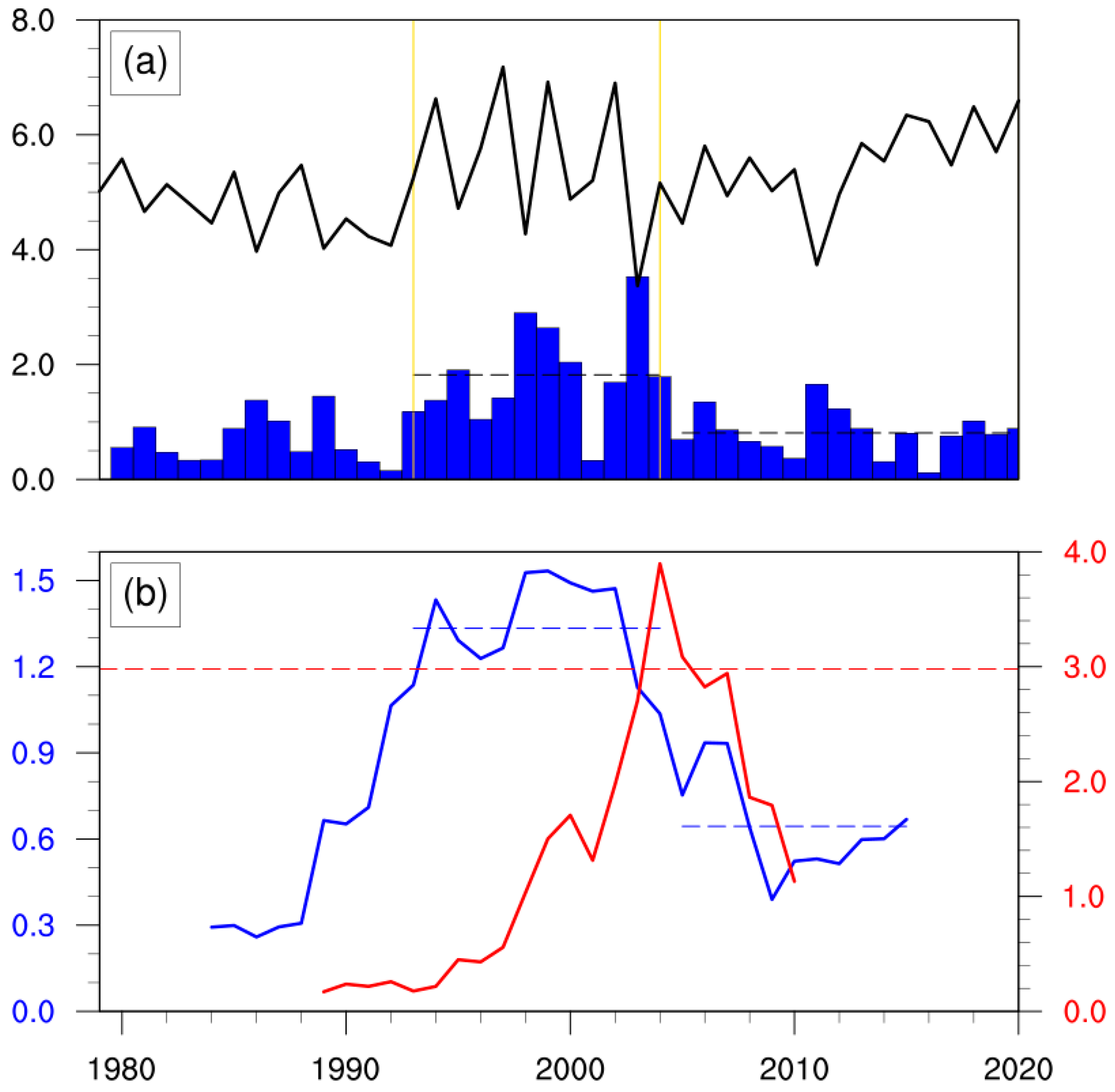
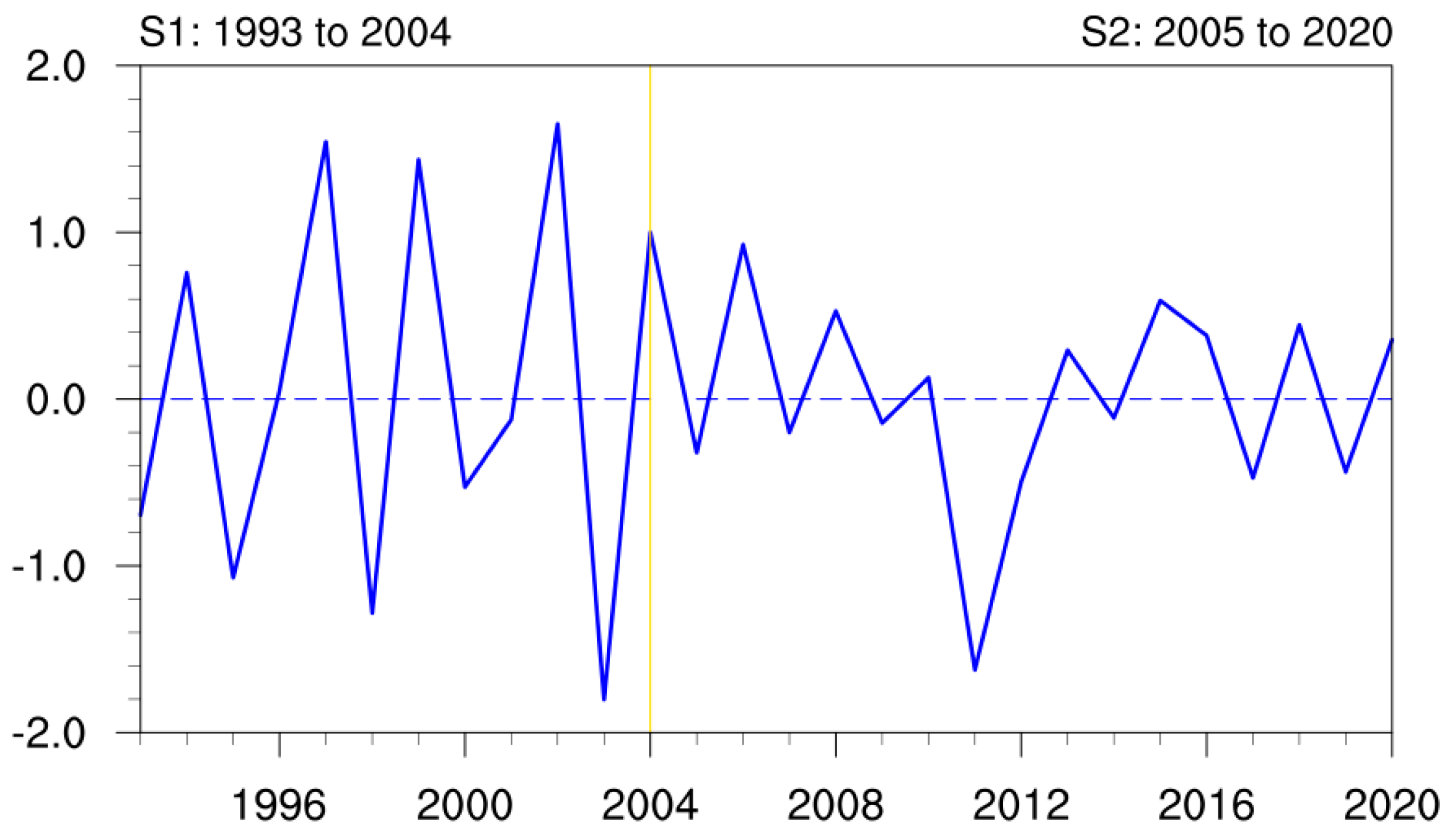
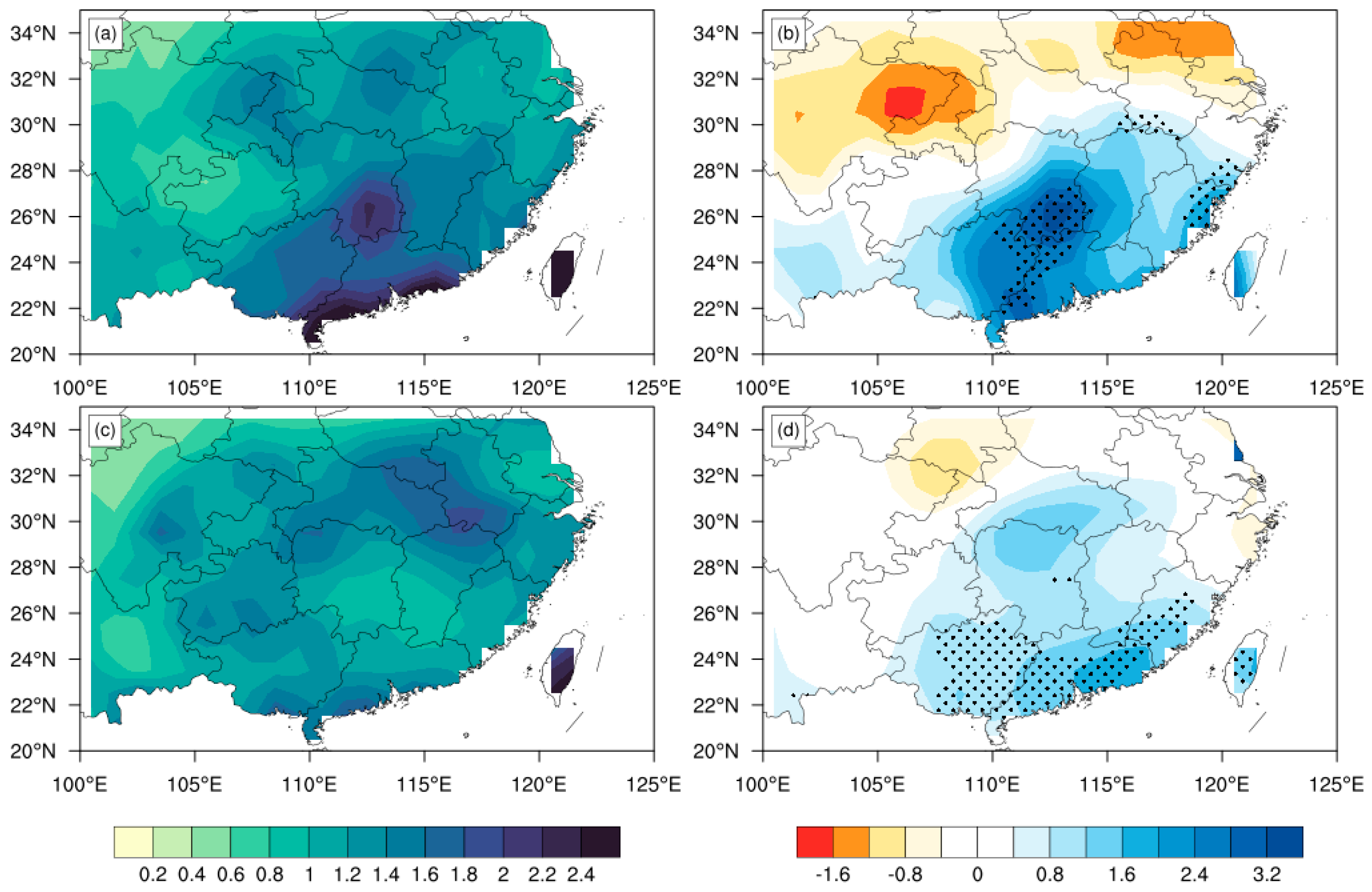

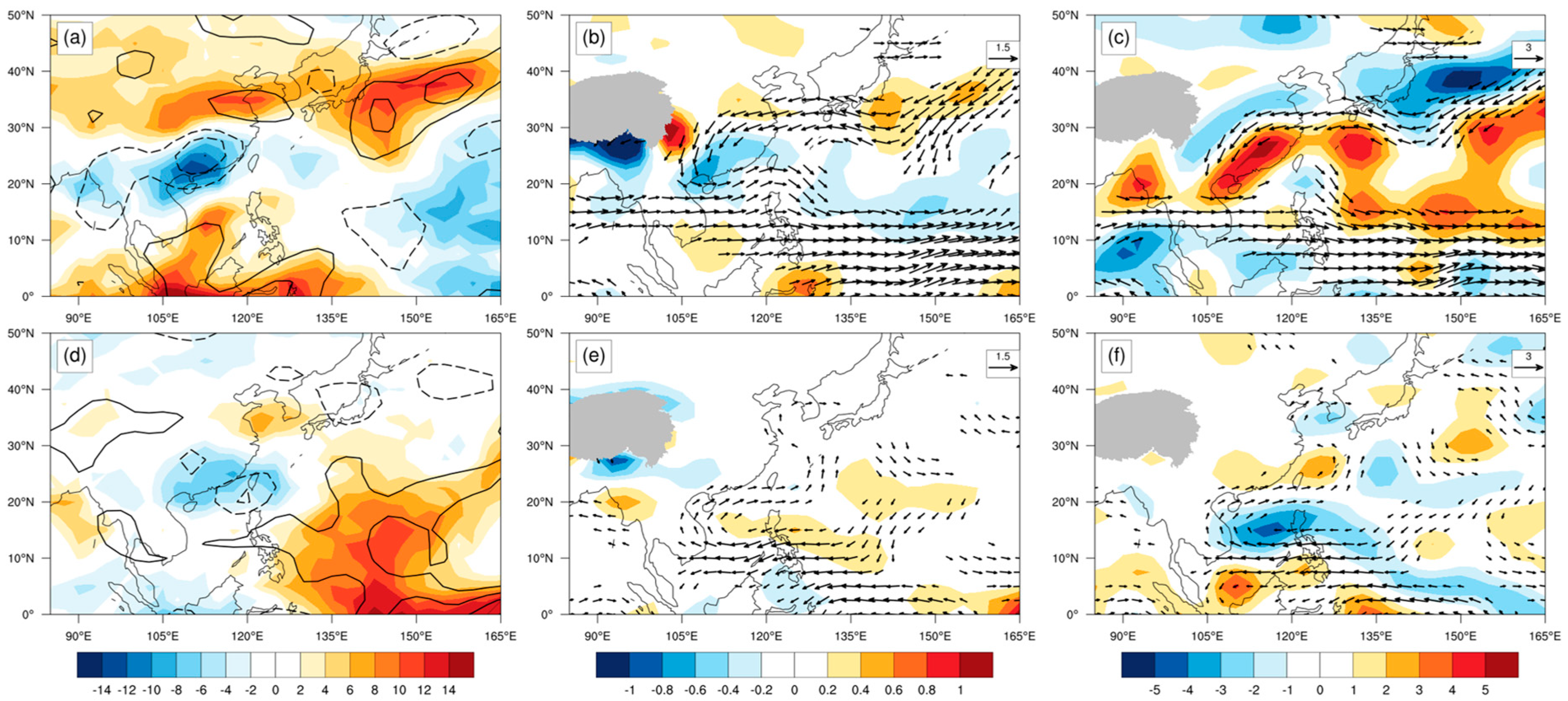
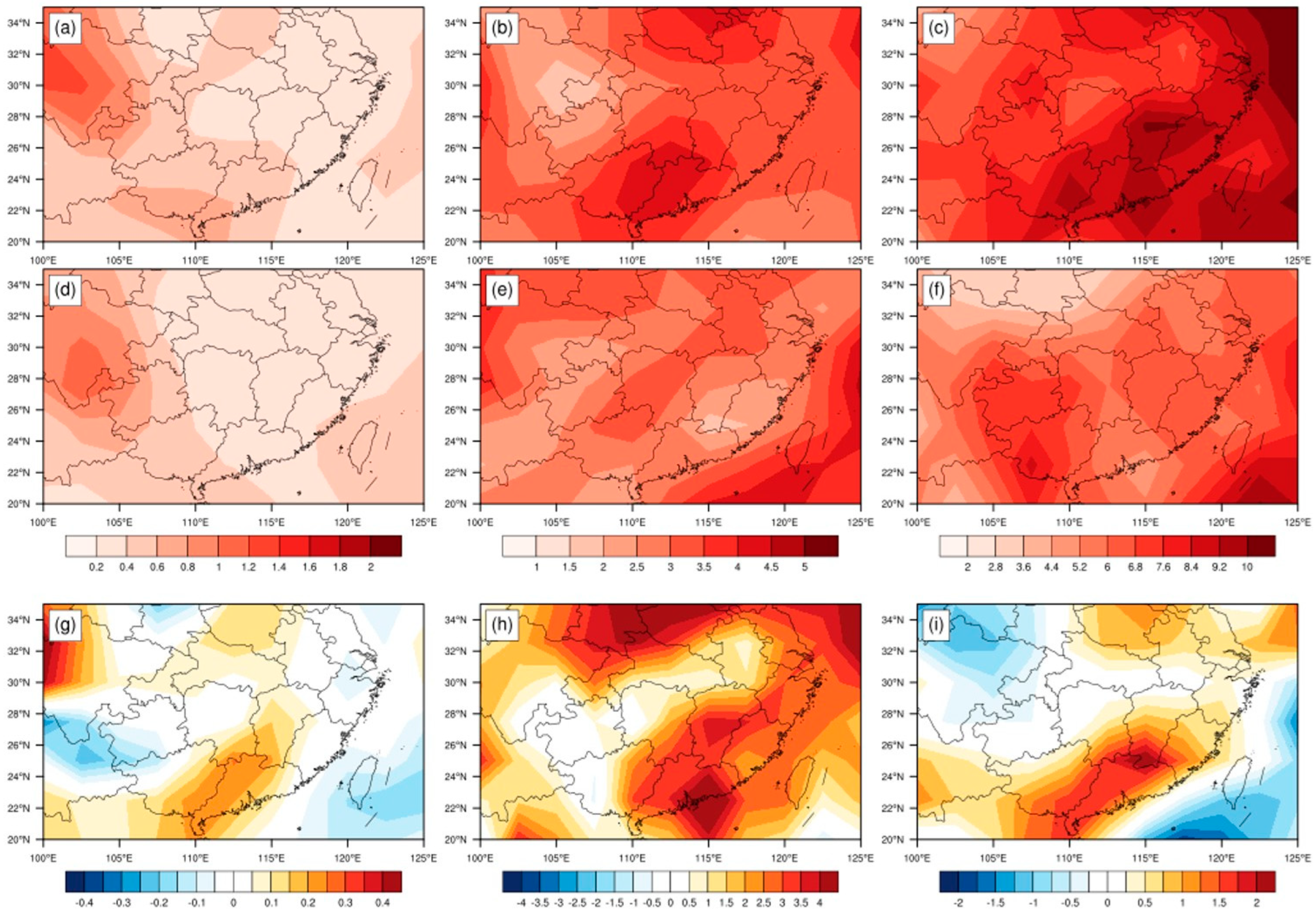
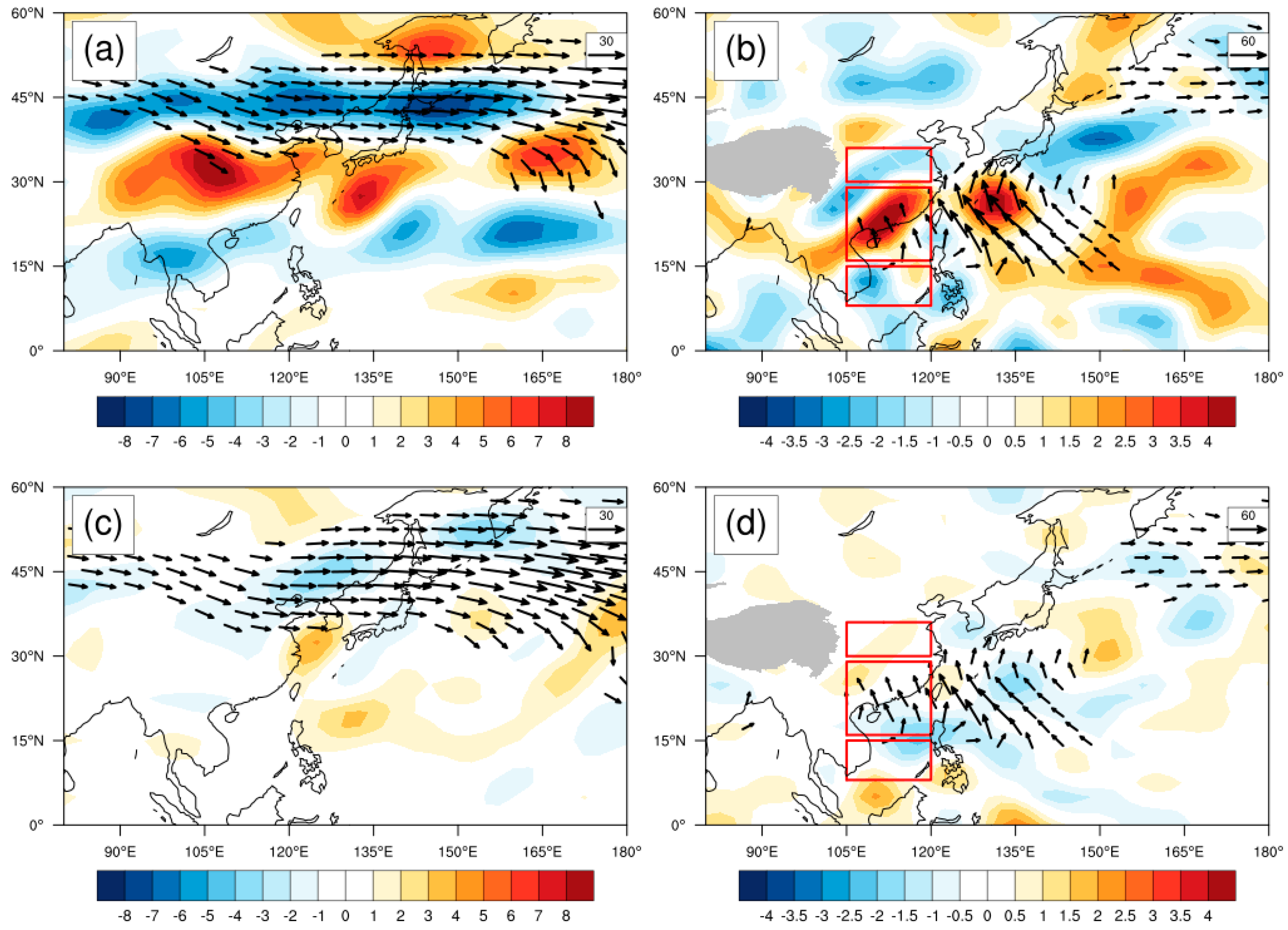
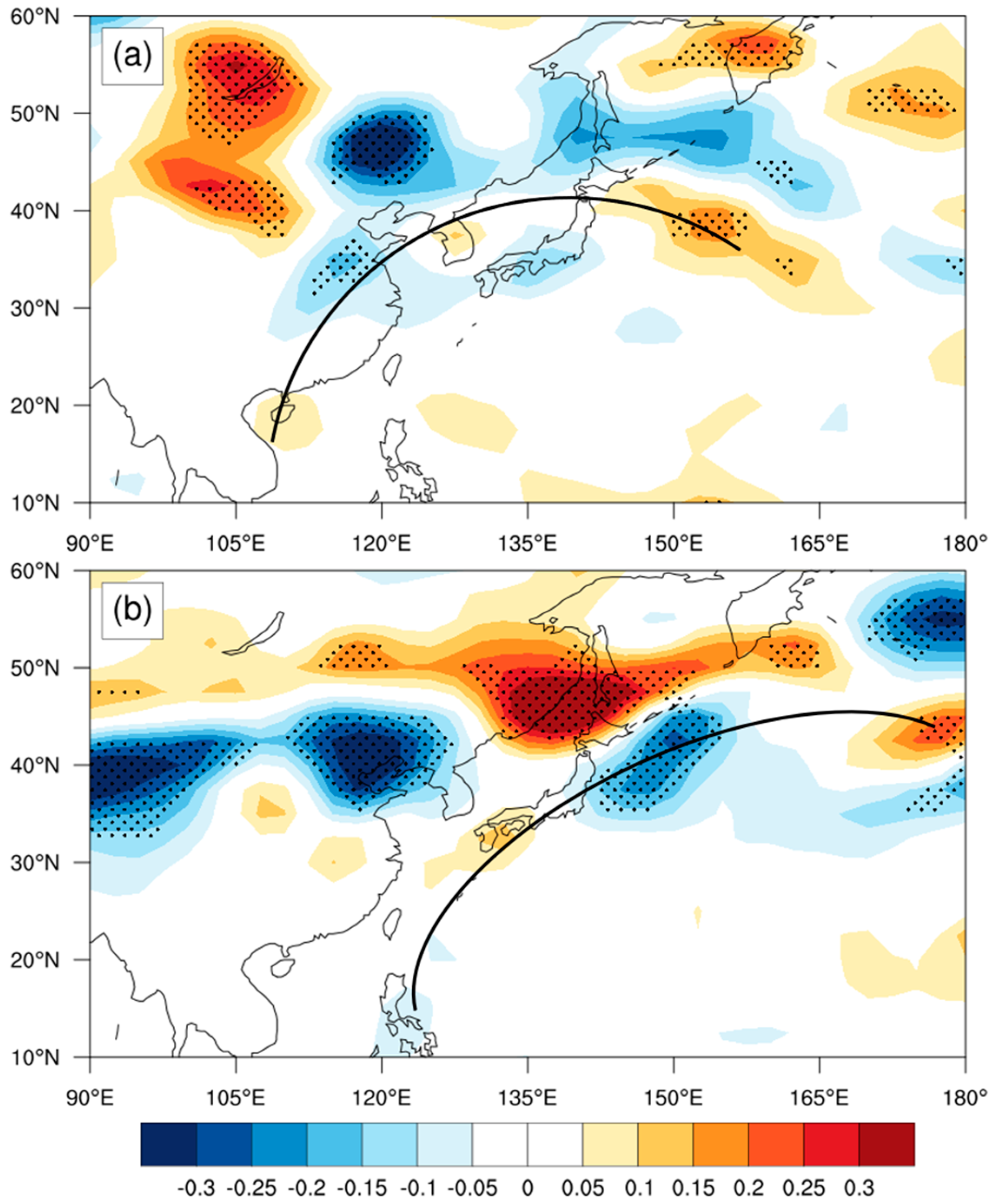
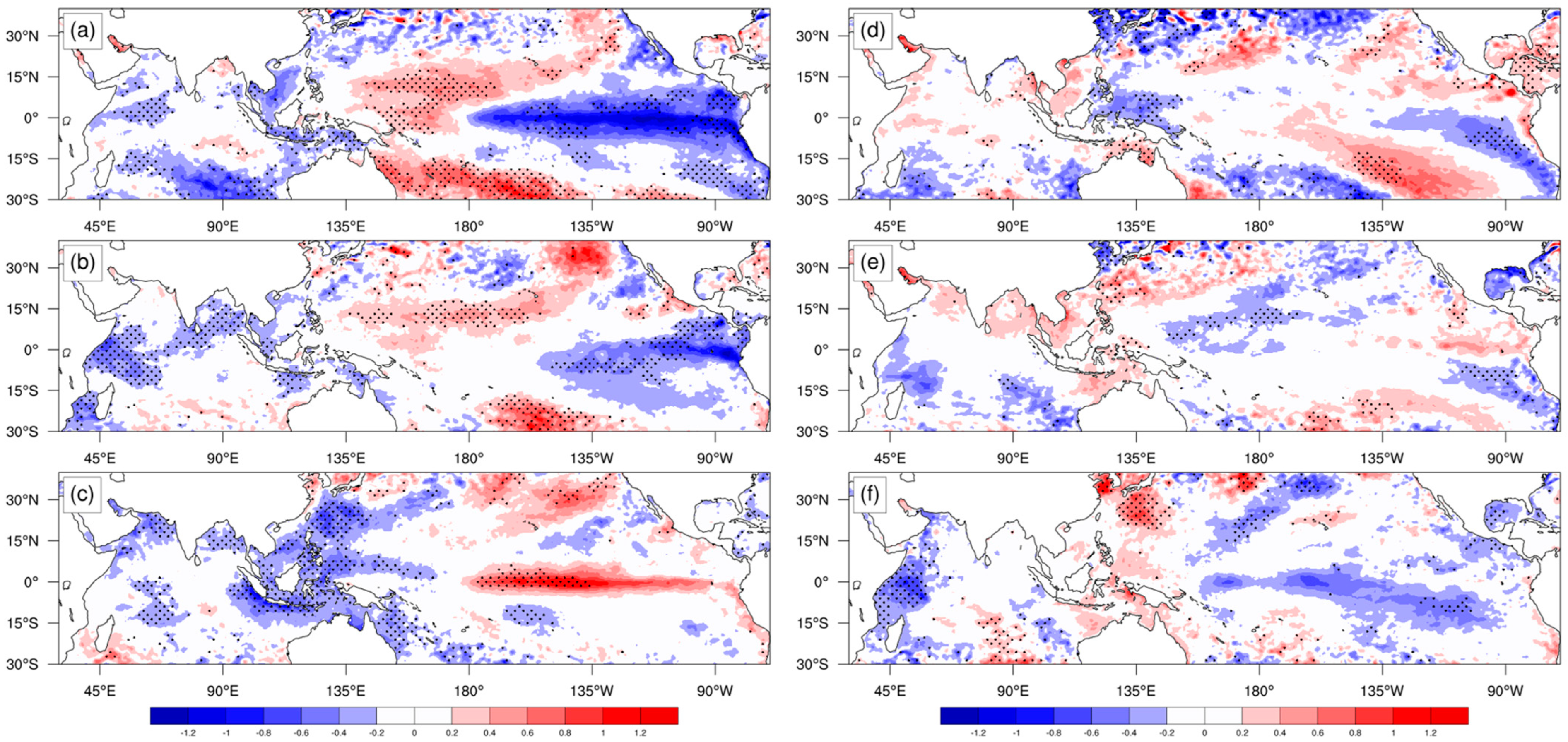
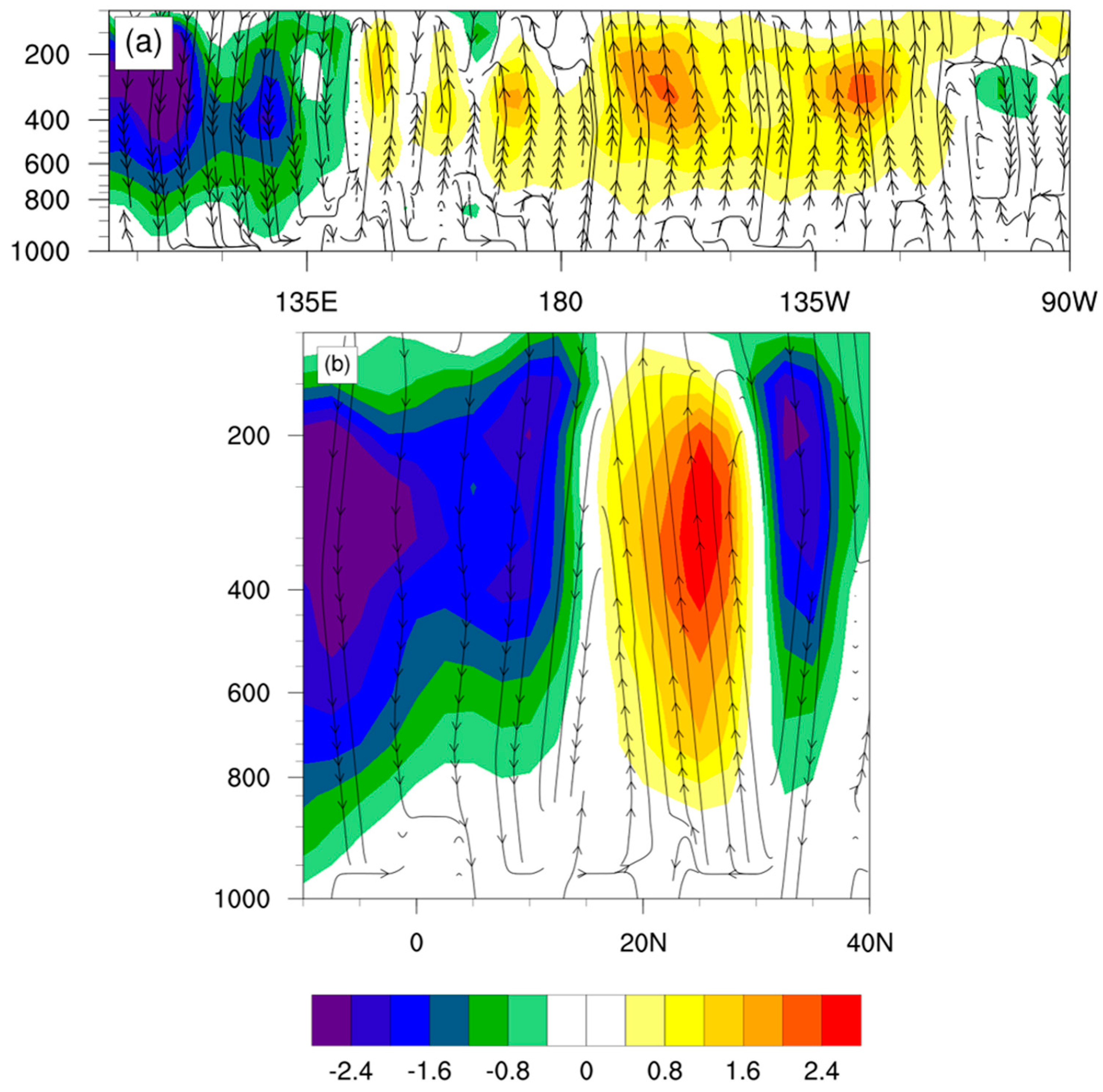
| S1 | S2 | |
|---|---|---|
| Wet years | 1994, 1996, 1997, 1999, 2002, 2004 | 2006, 2008, 2010, 2013, 2015, 2016, 2018, 2020 |
| Dry years | 1993, 1995, 1998, 2000, 2001, 2003 | 2005, 2007, 2009, 2011, 2012, 2014, 2017, 2019 |
Publisher’s Note: MDPI stays neutral with regard to jurisdictional claims in published maps and institutional affiliations. |
© 2022 by the authors. Licensee MDPI, Basel, Switzerland. This article is an open access article distributed under the terms and conditions of the Creative Commons Attribution (CC BY) license (https://creativecommons.org/licenses/by/4.0/).
Share and Cite
Lu, W.; Zhu, Y.; Zhong, Z.; Hu, Y.; Ha, Y. Weakened Impacts of the East Asia-Pacific Teleconnection on the Interannual Variability of Summertime Precipitation over South China since the Mid-2000s. Remote Sens. 2022, 14, 5098. https://doi.org/10.3390/rs14205098
Lu W, Zhu Y, Zhong Z, Hu Y, Ha Y. Weakened Impacts of the East Asia-Pacific Teleconnection on the Interannual Variability of Summertime Precipitation over South China since the Mid-2000s. Remote Sensing. 2022; 14(20):5098. https://doi.org/10.3390/rs14205098
Chicago/Turabian StyleLu, Wei, Yimin Zhu, Zhong Zhong, Yijia Hu, and Yao Ha. 2022. "Weakened Impacts of the East Asia-Pacific Teleconnection on the Interannual Variability of Summertime Precipitation over South China since the Mid-2000s" Remote Sensing 14, no. 20: 5098. https://doi.org/10.3390/rs14205098
APA StyleLu, W., Zhu, Y., Zhong, Z., Hu, Y., & Ha, Y. (2022). Weakened Impacts of the East Asia-Pacific Teleconnection on the Interannual Variability of Summertime Precipitation over South China since the Mid-2000s. Remote Sensing, 14(20), 5098. https://doi.org/10.3390/rs14205098







